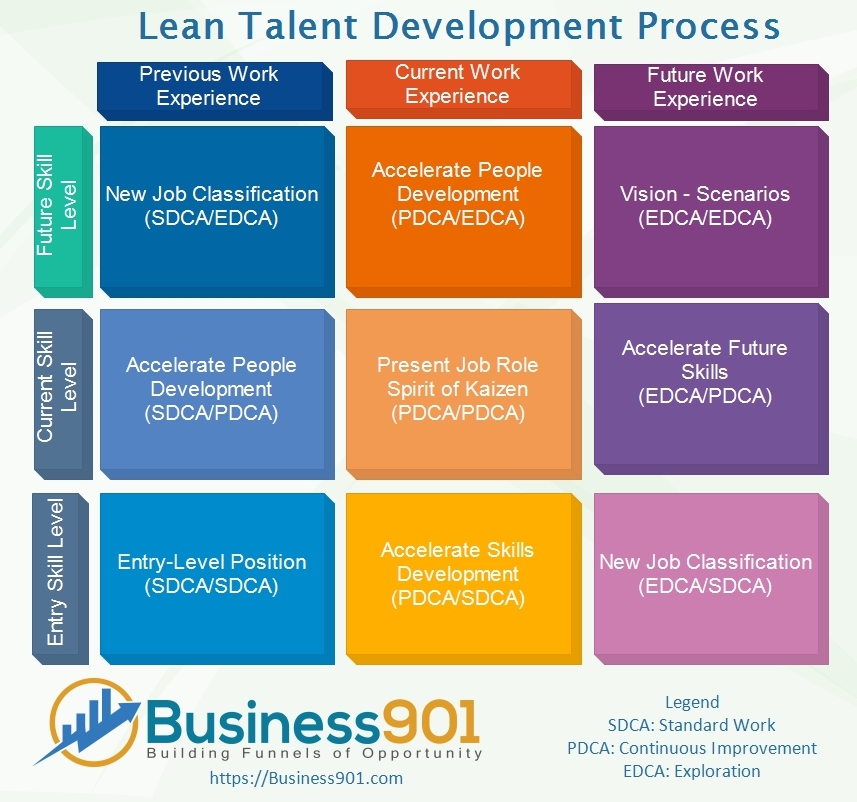The diagram is a very high-level view of thinking in Lean terms for talent development. So, often we tend to view Standard Work, Continuous Improvement and Exploration from only a tool perspective. Stepping back and taking the 20,000-foot level view can be beneficial.
Think of the middle box as the present job skills, job experience and proficiency needed. In the spirit of Lean, Kaizen we look for continuous improvement to be occurring. As a Lean company, we are committed to developing standard work. However, part of standard work is constantly obsoleting it through continuous improvement. Using this matrix and combine forecasting through exploration, we complement and prepare our organization, our workforce through the future.
As you look move diagonally to the left and down the bottom left box would be someone at an entry-level proficiency. As we onboard that person, what are the skills and job requirements required to move to the center of the matrix?
When we look at the future, where do we think this role is headed. Th future scenario and moving to the right or up we can dictate what type of development is needed for the position and who bets fits into what scenario. Even on a broader perspective, will we have the necessary future skills or job experience required?
The 4 corner boxes dictate the extremes for the job role.
- Bottom left, is entry level and looking backward from the middle. However, if we monitor that closely, we may see more experience or a better fit, job experience being available for this job role at different times.
- Over at the bottom right would possibly be someone that has not developed the needed skills required for this job in the future. It may lead us to develop and break the job down into subsets or other types of training, not to exclude accelerated skill development.
- The top left is the direct opposite of the bottom right. It is a matter of someone being overqualified for the position. This person may be ultimately suited for a different type of position as they may be on the fast track but lack the work experience to succeed in this role. If not addressed, this person is very likely to leave the company to find a better-suited position.
- The top right is the fuzzy area. Here we need to create a few different scenarios of what this role may look like in 3 to 5 years. Understanding company vision, outside influences, technology, and trends are important. Right or wrong if you address both skills and required work experience, you will have laid a strong foundation for whatever might take place. The point is not being exactly right but being forward thinking in your training and work practices. This way, job roles will be more likely to evolve versus change overnight. There are few black swans when we adequately prepare.
The remaining four boxes adjacent to the center is where most of the development occurs. The bottom ones adjacent to standard work is straight forward. We create our PDCA practice areas, such as Kata to identify weaknesses, either people/skill areas to move people into the center box. The upper adjacent boxes proceed from our practice areas towards the unknown, exploration or EDCA. We take what we know and add new skills to where we think we are going; what our vision or scenarios indicate. This may seem to be wasteful, but in either case, we will often develop competency for new areas and even send people towards the corner boxes.
With the matrix, I have been playing around with it to do a couple of things.
- Using the 9 windows TRIZ approach, I have used the entire 9 boxes to look at systems from an individual, team, or department in sort of a SWOT analysis.
- I have used it to evaluate how individuals fit into different roles and what sort of development will be needed, whether people or job skill training.
- If you evaluate a group of people along this entire matrix, should you attempt to have them evenly distributed through out? Would you have clusters?
- If you evaluate your entire organization, would you have different clusters with different job roles? Would your organization overly the same throughout?
Do you have others?
Background: This 9-box matrix is loosely based on the Lean Product Development Process and the 9 Windows Diagram from TRIZ.
- The 9 Windows Diagram enables you to look at opportunities across the dimensions of time (past, present, future) and space (supersystem, system, subsystem). In other words, it gives you a set of tools that you can use to consider your opportunity by breaking it into smaller pieces as well as considering the larger context into which it fits.
- Lean Product Development looks at a system through the development of a new product concurrently with the process that will produce it, by the people who will interact with it. Lean 3P, for example, is labeled Production, Preparation, Process. Lean Product Development is very similar usually using the trio of People, Process, Technology.

